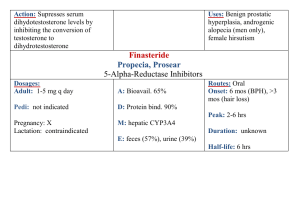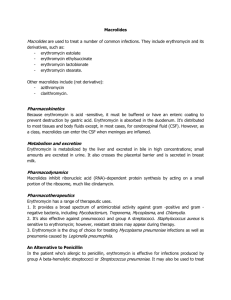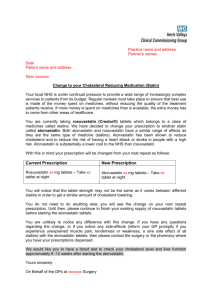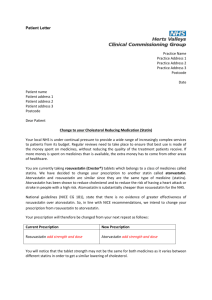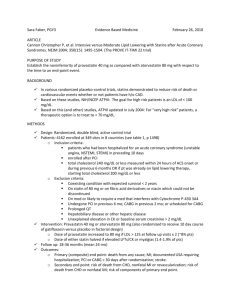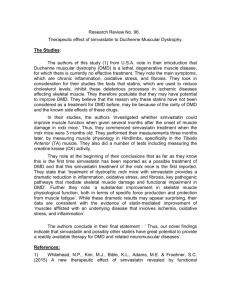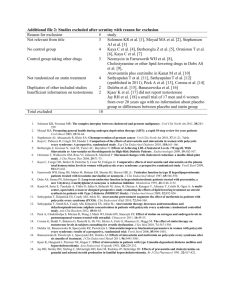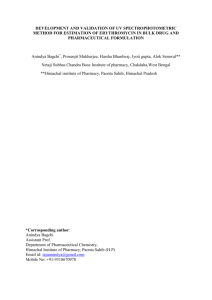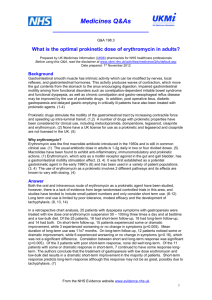Interactions between erythromycin and statins.
advertisement
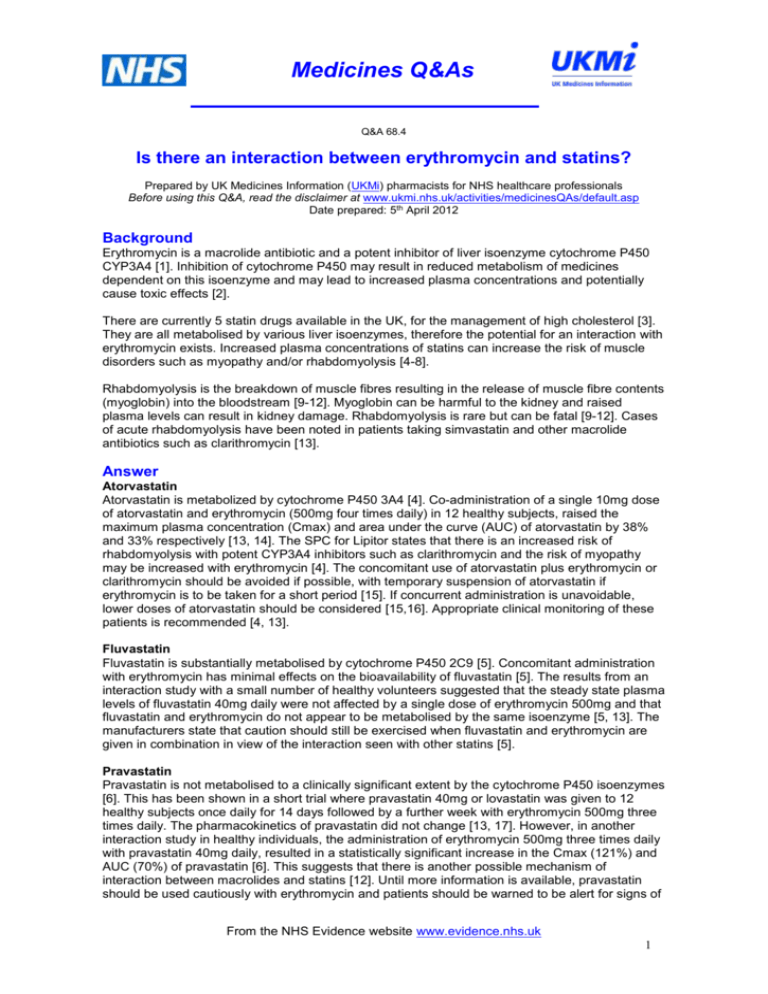
Medicines Q&As Q&A 68.4 Is there an interaction between erythromycin and statins? Prepared by UK Medicines Information (UKMi) pharmacists for NHS healthcare professionals Before using this Q&A, read the disclaimer at www.ukmi.nhs.uk/activities/medicinesQAs/default.asp Date prepared: 5th April 2012 Background Erythromycin is a macrolide antibiotic and a potent inhibitor of liver isoenzyme cytochrome P450 CYP3A4 [1]. Inhibition of cytochrome P450 may result in reduced metabolism of medicines dependent on this isoenzyme and may lead to increased plasma concentrations and potentially cause toxic effects [2]. There are currently 5 statin drugs available in the UK, for the management of high cholesterol [3]. They are all metabolised by various liver isoenzymes, therefore the potential for an interaction with erythromycin exists. Increased plasma concentrations of statins can increase the risk of muscle disorders such as myopathy and/or rhabdomyolysis [4-8]. Rhabdomyolysis is the breakdown of muscle fibres resulting in the release of muscle fibre contents (myoglobin) into the bloodstream [9-12]. Myoglobin can be harmful to the kidney and raised plasma levels can result in kidney damage. Rhabdomyolysis is rare but can be fatal [9-12]. Cases of acute rhabdomyolysis have been noted in patients taking simvastatin and other macrolide antibiotics such as clarithromycin [13]. Answer Atorvastatin Atorvastatin is metabolized by cytochrome P450 3A4 [4]. Co-administration of a single 10mg dose of atorvastatin and erythromycin (500mg four times daily) in 12 healthy subjects, raised the maximum plasma concentration (Cmax) and area under the curve (AUC) of atorvastatin by 38% and 33% respectively [13, 14]. The SPC for Lipitor states that there is an increased risk of rhabdomyolysis with potent CYP3A4 inhibitors such as clarithromycin and the risk of myopathy may be increased with erythromycin [4]. The concomitant use of atorvastatin plus erythromycin or clarithromycin should be avoided if possible, with temporary suspension of atorvastatin if erythromycin is to be taken for a short period [15]. If concurrent administration is unavoidable, lower doses of atorvastatin should be considered [15,16]. Appropriate clinical monitoring of these patients is recommended [4, 13]. Fluvastatin Fluvastatin is substantially metabolised by cytochrome P450 2C9 [5]. Concomitant administration with erythromycin has minimal effects on the bioavailability of fluvastatin [5]. The results from an interaction study with a small number of healthy volunteers suggested that the steady state plasma levels of fluvastatin 40mg daily were not affected by a single dose of erythromycin 500mg and that fluvastatin and erythromycin do not appear to be metabolised by the same isoenzyme [5, 13]. The manufacturers state that caution should still be exercised when fluvastatin and erythromycin are given in combination in view of the interaction seen with other statins [5]. Pravastatin Pravastatin is not metabolised to a clinically significant extent by the cytochrome P450 isoenzymes [6]. This has been shown in a short trial where pravastatin 40mg or lovastatin was given to 12 healthy subjects once daily for 14 days followed by a further week with erythromycin 500mg three times daily. The pharmacokinetics of pravastatin did not change [13, 17]. However, in another interaction study in healthy individuals, the administration of erythromycin 500mg three times daily with pravastatin 40mg daily, resulted in a statistically significant increase in the Cmax (121%) and AUC (70%) of pravastatin [6]. This suggests that there is another possible mechanism of interaction between macrolides and statins [12]. Until more information is available, pravastatin should be used cautiously with erythromycin and patients should be warned to be alert for signs of From the NHS Evidence website www.evidence.nhs.uk 1 Version 5.0 Revised July 2009 myopathy (i.e. unexplained muscle pain, tenderness or weakness or dark coloured urine [6, 13, 15, 16]. Rosuvastatin Rosuvastatin undergoes limited metabolism with approximately 90% of the dose being excreted unchanged in the faeces [7, 13]. The other 10% is metabolised principally by isoenzyme 2C9 and 2C19 [7, 13]. Rosuvastatin is neither an inhibitor nor inducer of cytochrome P450 isoenzymes [7]. Concomitant use of erythromycin (500mg four times daily for 7 days) and a single 80mg dose of rosuvastatin in 11 healthy subjects resulted in a 20% decrease in AUC and a 30% decrease in Cmax of rosuvastatin [18]. This interaction may be caused by the increase in gut motility caused by erythromycin. It is not considered to be clinically relevant, if short-term courses of erythromycin are used [7, 13, 18]. Simvastatin Simvastatin is metabolised by cytochrome P450 3A4 [8, 13]. Potent inhibitors of cytochrome P450 3A4 such as erythromycin and some other macrolides increase plasma levels of simvastatin and significantly increasing the risk of myopathy and rhabdomyolysis during concomitant treatment. In an interaction study, a single dose of simvastatin 40mg was given to 12 healthy individuals. After 2 days of placebo or erythromycin (500mg three times daily), the plasma levels and AUC of simvastatin and its active metabolite were increased 6.2-fold and 3.9-fold respectively [19]. An 80-year old gentleman was admitted to hospital, following a one week history of myalgia and inability to walk. Investigations revealed elevated liver function tests, myoglobinuria and high creatine kinase. He subsequently developed renal failure requiring haemofiltration. His drug history showed a four week course of erythromycin whilst concurrently taking simvastatin. The authors concluded that the patient had experienced a delayed interaction between a past completed four week course of erythromycin and simvastatin. The patient made a full recovery [20]. A man aged 83-years who was receiving stable therapy with simvastatin 80mg per day was hospitalized with rhabdomyolysis for 1 to 2 weeks following treatment with erythromycin, (500mg four times daily), for 10 days for pneumonia. Four weeks after taking the erythromycin he experienced myalgia, muscle weakness, functional disability and serum creatine kinase levels more than 60 times the upper limit of normal. He made a full recovery [21]. In a study which collated spontaneous reports of rhabdomyolysis in patients on statins and CYP3A4 inhibitors; 2 cases of rhabdomyolysis with erythromycin were reported. No further details were given [22]. A 70-year old man developed myalgia and fatal rhadomyolysis after receiving a 4 week course of erythromycin 250mg QDS concomitantly with his regular simvastatin 40mg daily [23]. A review in 2007, concluded that there was no compelling reason for preferring atorvastatin to simvastatin from the point of view of drug interactions related to metabolism by CYP3A4 [24]. The MHRA and FDA advise that simvastatin should not be co-administered with erythromycin and the combination of simvastatin and erythromycin is contraindicated. If concomitant use is unavoidable, therapy with simvastatin must be suspended during the course of antibiotic treatment [8, 15, 25, 26]. Summary Erythromycin raises the plasma levels of statins which are metabolised by cytochrome P450 isoenzyme 3A4 (i.e. atorvastatin and simvastatin), but in practice not all patients are affected [13]. Simvastatin is contra-indicted in patients taking erythromycin and should be withdrawn if the antibiotic is required [8, 13, 15, 16. 25, 26]. Atorvastatin and erythromycin should be used together with caution. It may be prudent to withhold atorvastatin if erythromycin treatment is required to avoid any potential adverse effects [4, 13, 15, 16]. If concurrent administration is unavoidable, then a lower dose of atorvastatin should be considered. 2 From the NHS Evidence website www.evidence.nhs.uk Version 5.0 Revised July 2009 Fluvastatin, pravastatin and rosuvastatin are not metabolised by cytochrome P450 3A4, however pravastatin exposure was possibly slightly increased by erythromycin, suggesting that another mechanism of interaction may be involved [5, 6 13, 15]. Rosuvastatin and fluvastatin do not appear to be affected by erythromycin in pharmacokinetic studies, and therefore an increased risk of rhabdomyolysis with these statins and erythromycin would seem unlikely. However until more information is available in relation to other potential interaction mechanisms, caution is advised with the concomitant use of erythromycin with fluvastatin, pravastatin and rosuvastatin [5, 6, 13,15]. If co-prescription with a drug that increases systemic exposure to statins is unavoidable, it is particularly important to start on the lowest statin dose [15]. Any patient who is given a statin concomitantly with a macrolide antibiotic, such as erythromycin or clarithromycin, should be warned to be alert for any signs of myopathy (i.e. unexplained muscle pain, tenderness or weakness or dark coloured urine). If myopathy does occur, the statin should be stopped immediately [13]. Limitations The clinical significance of enzyme inhibition interactions depends on the extent to which the serum levels of the drug rise. Information on the interaction between erythromycin and statins is limited to reports of small interaction studies conducted in healthy individuals. Interactions between statins and other macrolide antibiotics have not been considered in this Q&A. References 1. Erythromycin monograph. In Sweetman, SC (ed), Martindale: The Complete Drug Reference Online. London. Pharmaceutical Press; 2012. Accessed via http://www.medicinescomplete.com 08/03/12. 2. Drug metabolism (biotransformation) interactions. In Baxter K(ed). Stockley’s Drug Interactions online. London: Pharmaceutical Press; 2012. Accessed via http://www.medicinescomplete.com on 05/04/2012. 3. Martin J, editor. British National Formulary No 62 London: British Medical Association and The Royal Pharmaceutical Society of Great Britain; March 2012. Accessed 08/03/2012 via http://www.bnf.org.uk. 4. Summary of Product Characteristics - Lipitor. Pfizer Ltd. Date of last revision of text December 2011. Accessed via http://emc.medicines.org.uk on 12/03/2012. 5. Summary of Product Characteristics - Lescol. Novartis Pharmaceuticals UK Ltd. Date of last revision of text 16/09/2011. Accessed via http://emc.medicines.org.uk on 12/03/12. 6. Summary of Product Characteristics - Lipostat. Bristol-Myers Squibb Pharmaceuticals Ltd. Date of last revision of text: 30/11/2011. Accessed via http://emc.medicines.org.uk on 12/03.2012. 7. Summary of Product Characteristics - Crestor. AstraZeneca UK Ltd. Date of last revision of text: 20/12/2011. Accessed via http://emc.medicines.org.uk on 12/03/12. 8. Summary of Product Characteristics - Zocor. Merck Sharp & Dohme Ltd. Date of last revision of text: March 2011. Accessed via http://emc.medicines.org.uk on 12/03/2012. 9. Rhadomyolysis In: Medline Plus Medical Encyclopedia. Last updated 19/09/2011. Accessed via http://www.nlm.nih.gov/medlineplus/ency/article/000473.htm on 02/04/2012 10. Lane R, Philips M. Rhabdomyolysis; has many causes, including statins, and can be fatal (editorial). British Medical Journal 2003; 327: 115-116. 11. Bosch X, Poch E et al. Rhabdomyolysis and acute kidney injury. New England Journal of Medicine 2009; 361:62-72. 12. Lipid Regulating Drugs. In Baxter K (ed), Stockley’s Drug Interactions. Online. London. Pharmaceutical press 2012. Accessed via http://www.medicinescomplete,com on 08/03/2012. 13. Statins + macrolides. In Baxter K (ed). Stockley’s Drug Interactions. Online London: Pharmaceutical Press. 2012. Accessed via http://www.medicinescomplete.com on 08/03/12. 14. Siedlik PH, Olson SC et al. Erythromycin co-administration increases plasma atorvastatin concentrations. Journal of Clinical Pharmacology 1999; 39: 501-4. 15. Statins: interactions, and updated advice for atorvastatin. Drug Safety Update (MHRA) 2008; 1 (6): 2-4. 3 From the NHS Evidence website www.evidence.nhs.uk Version 5.0 Revised July 2009 16. Anon. Drug interactions that can occur with statins and macrolide anti-bacterials. Pharmaceutical Journal 2008; 280: 63. 17. Bottorff MB, Behrens DH et al. Differences in metabolism of lovastatin and pravastatin as assessed by CYP3A4 inhibition with erythromycin. Pharmacotherapy 1997; 17: 184. 18. Cooper KJ, Martin PD et al. The effect of erythromycin on the pharmacokinetics of rosuvastatin. European Journal of Clinical Pharmacology 2003; 59: 51-6. 19. Kantola T et al. Erythromycin and verapamil considerably increase serum simvastatin and simvastatin acid concentrations. Clinical Pharmacology and Therapeutics 1998; 64: 177-82 20. Campbell G, Jayakumar U et al. A cautionary tale: delayed onset rhabdomyolysis due to erythromycin/simvastatin interaction. Age and Ageing 2007; 36: 597-597. 21. Molden E, Svendsen Andersson K. Simvastatin associated rhabdomyolysis after coadministration of macrolide antibiotics in two patients. Pharmacotherapy 2007; 27(4) 603607. 22. Rowan C, Brinker AD et al. Rhabdomyolysis reports show interaction between simvastatin and CYP3A4 inhibitors. Pharmacoepidemiology and Drug Safety 2009; 18: 301-309. 23. Dubash SR, Tarique S et al. A Fatal combination: Rhabdomyolysis after macrolide therapy and a long term statin. Rheumatology, April 2010; 49: i7. 24. Anon. Which statin, what dose? Drugs and Therapeutics Bulletin 2007; 45 (5): 33-37. 25. Erythromycin and other macrolides: focus on interactions. Current Problems in Pharmacovigilance 2006; 31: 8. 26. FDA Drug Safety communication: Ongoing safety review of high dose Zocor (simvastatin) and increased risk of muscle injury. United States Food and Drug administration. Published 19th March 2010. Accessed 22/03/2012 via http://www.fda.gov/Drugs/DrugSafety/PostmarketingDrugsafetyinformationfor patientsandProviders/ucm204882.htm. Quality Assurance Prepared by Vicky Gibson, East Anglia Medicines Information Service (based on earlier work by Katie Smith). Date Prepared 5th April 2012 Checked by Sarah Cavanagh, East Anglia Medicines Information Service Date of check 19th April 2012 Search strategy Embase: erythromycin or macrolides +HMG-COA reductase inhibitors or atorvastatin or fluvastatin or pravastatin or rosuvastatin or simvastatin. Medline: erythromycin or macrolides + HMG-COA reductase inhibitors or atorvastatin or fluvastatin or pravastatin or rosuvastatin or simvastatin. IDIS: HMG-COA reductase inhibitors or atorvastatin or fluvastatin or pravastatin or rosuvastatin or simvastatin + erythromycin. Pharmline: atorvastatin or fluvastatin or pravastatin or rosuvastatin or simvastatin + erythromycin). Electronic Medicines Compendium: summaries of product characteristics for atorvastatin, fluvastatin, pravastatin, rosuvastatin & simvastatin DrugDex online: monographs for atorvastatin, fluvastatin, pravastatin, rosuvastatin, simvastatin and erythromycin Stockley’s Drug Interactions.Online Meyler’s Side effects of Drugs 15th edition. 4 From the NHS Evidence website www.evidence.nhs.uk
